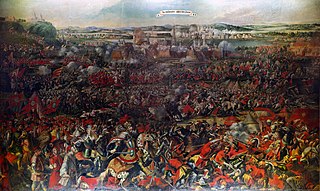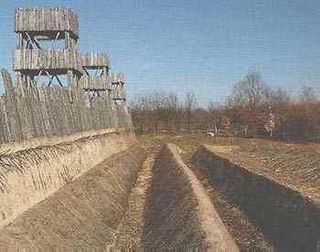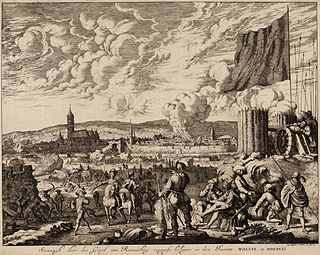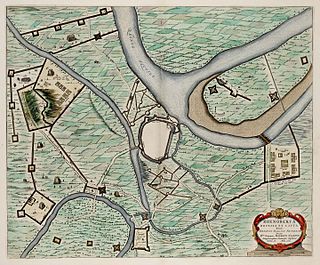
The Battle of Vienna took place at Kahlenberg Mountain near Vienna on 12 September 1683 after the imperial city had been besieged by the Ottoman Empire for two months. The battle was fought by the Holy Roman Empire led by the Habsburg Monarchy and the Polish–Lithuanian Commonwealth, both under the command of King John III Sobieski, against the Ottomans and their vassal and tributary states. The battle marked the first time the Commonwealth and the Holy Roman Empire had cooperated militarily against the Ottomans, and it is often seen as a turning point in history, after which "the Ottoman Turks ceased to be a menace to the Christian world". In the ensuing war that lasted until 1699, the Ottomans lost almost all of Hungary to the Holy Roman Emperor Leopold I.

The Battle of Alesia or Siege of Alesia was a military engagement in the Gallic Wars that took place in September, 52 BC, around the Gallic oppidum of Alesia, a major centre of the Mandubii tribe. It was fought by the army of Julius Caesar against a confederation of Gallic tribes united under the leadership of Vercingetorix of the Arverni. It was the last major engagement between Gauls and Romans, and is considered one of Caesar's greatest military achievements and a classic example of siege warfare and investment. The battle of Alesia marked the end of Gallic independence in France and Belgium.

In baseball and softball, a relief pitcher or reliever is a pitcher who enters the game after the starting pitcher is removed due to injury, ineffectiveness, fatigue, ejection, or for other strategic reasons, such as inclement weather delays or pinch hitter substitutions. Relief pitchers are further divided informally into various roles, such as closers, setup men, middle relief pitchers, left/right-handed specialists, and long relievers. Whereas starting pitchers usually rest several days before pitching in a game again due to the number of pitches thrown, relief pitchers are expected to be more flexible and typically pitch more games but with fewer innings pitched. A team's staff of relievers is normally referred to metonymically as a team's bullpen, which refers to the area where the relievers sit during games, and where they warm-up prior to entering the game.

The Apprentice Boys of Derry is a Protestant fraternal society with a worldwide membership of over 10,000, founded in 1814 and based in the city of Derry, Northern Ireland. There are clubs and branches in Ulster and elsewhere in Ireland, Scotland, England, Australia and Toronto, Canada. The society aims to commemorate the 1689 Siege of Derry when Catholic James II of England and Ireland and VII of Scotland laid siege to the walled city, which was at the time a Protestant stronghold. Apprentice Boys parades once regularly led to virulent opposition from the city's Irish nationalist majority, but recently a more conciliatory approach has taken place and now the parades are virtually trouble-free. The 2014 'Shutting of the Gates' parade was described as "the biggest in years" and was violence-free.

The Battle of St. Quentin was a battle of the Franco-Prussian War in which Prussian forces defeated French attempts to relieve the besieged city of Paris.

The 1545–1546 Siege of Kawagoe Castle was part of a failed attempt by the Uesugi clan to regain Kawagoe Castle from the Later Hōjō clan in the Sengoku period of Japan.

The Siege of Leiden occurred during the Eighty Years' War and the Anglo–Spanish War in 1573 and 1574, when the Spanish under Francisco de Valdez attempted to capture the rebellious city of Leiden, South Holland, the Netherlands. The siege failed when the city was successfully relieved in October 1574.

The Siege of Saint-Martin-de-Ré, also Siege of St. Martin's, was an attempt by English forces under George Villiers, the Duke of Buckingham to capture the French fortress-city of Saint-Martin-de-Ré, on the isle of Ré, in 1627. After three months of siege the Marquis de Toiras and a relief force of French ships and troops managed to repel the Duke, who was forced to withdraw in defeat. The encounter followed another defeat for Buckingham, the 1625 Cádiz Expedition and is considered to be the opening conflict of the Anglo-French War of 1627-1629.

The First Battle of Hanna was a World War I battle fought on the Mesopotamian front on 21 January 1916 between Ottoman Army and Anglo-Indian forces.

The Mughal–Safavid War of 1622–1623 was fought over the important fortress city of Kandahar, in Afghanistan, between the Safavid empire and the Mughal empire.

The Siege of Calais of 1596, also known as the Spanish conquest of Calais, took place at the strategic port-city of Calais, between April 8–24, 1596, as part of the Franco-Spanish War (1595–1598), in the context of the French Wars of Religion, the Anglo-Spanish War (1585–1604), and the Eighty Years' War. The siege ended when the city fell into Spanish hands after a short and intense siege by the Spanish Army of Flanders commanded by Archduke Albert of Austria, Governor-General of the Spanish Netherlands. The French troops in the citadel of Calais resisted for a few days more, but finally on April 24, the Spanish troops led by Don Luis de Velasco y Velasco, Count of Salazar, assaulted and captured the fortress, achieving a complete victory. The Spanish success was the first action of the campaign of Archduke Albert of 1596.
The Siege of Ceuta of 1419 was fought between the besieging forces of the Marinid Sultanate of Morocco, led by Sultan Abu Said Uthman III, including allied forces from the Emirate of Granada, and the Portuguese garrison of Ceuta, led by Pedro de Menezes, 1st Count of Vila Real. After the loss of the city in a surprise attack in 1415 known as the Conquest of Ceuta, the Sultan gathered an army four years later and besieged the city. The Portuguese gathered a fleet under the command of Princes Henry the Navigator and John of Reguengos to relieve Ceuta. According to the chroniclers, the relief fleet turned out to be quite unnecessary. In a bold gambit, D. Pedro de Menezes led the Portuguese garrison in a sally against the Marinid siege camp and forced the lifting of the siege before the relief fleet even arrived.
The Siege of Perpignan was a siege during the Catalan Revolt.

The Siege of Steenwijk took place from October 18, 1580 – February 23, 1581 during the Eighty Years' War and the Anglo–Spanish War, between a besieging Spanish force under turncoat George van Lalaing against a Dutch rebel garrison at Steenwijk under Johan van den Kornput. An English and Dutch rebel force under John Norreys successfully relieved the town on January 24, and the Spanish in addition to ill-health and lack of supplies subsequently lifted the siege in February.
Relief, as a military term, refers to the breaking of a siege or an encirclement by an outside force. Relief may occur in conjunction with a breakout. It is one of four possible conclusions of investment, the others being a breakout, surrender or reduction. The force that effects relief is known as the "relieving force" or colloquially "rescue party". Following relief, the town or fortification is said to have been "relieved".

The Siege of Lochem also known as the Relief of Lochem was a siege that took place in the Dutch city of Lochem during the Eighty Years' War and the Anglo–Spanish War. The city was relieved by a States army composing of English and French Huguenot troops under Count Philip of Hohenlohe-Neuenstein and William Louis of Nassau-Dillenburg and John Norreys on September 24, 1582. This marked the end of the Spanish siege of the city by the Spanish general Francisco Verdugo.

The Siege of Sluis (1604), also known as the Sluis Campaign or the Battle of the Oostburg Line, was a series of military actions that took place during the Eighty Years' War and the Anglo–Spanish War from 19 May to 19 August 1604. A States and English army under Prince Maurice of Orange and Horace Vere respectively crossed the Scheldt estuary and advanced on land taking Cadzand, Aardenburg, and IJzendijke in the Spanish Netherlands. This soon led to the culmination of the siege of the Spanish-held inland port of Sluis.

The Siege of Coevorden was a siege that took place between 26 July and 2 September 1592 during the Eighty Years' War and the Anglo–Spanish War at the city of Coevorden by a Dutch and English force under overall command of Maurice of Nassau. The city was defended by Frederik van den Bergh who had been commissioned for the defence by King Philip II of Spain.

The Siege of Rheinberg, also known as the Rhine campaign of 1601, was the siege of the towns of Rheinberg and Meurs from 12 June to 2 August 1601 during the Eighty Years' War and the Anglo–Spanish War. Maurice of Orange with an Anglo-Dutch army besieged the Spanish-held cities in part to distract them before their impending siege at Ostend. Rheinberg, an important city, eventually capitulated on 28 July after a Spanish relief force under Herman van den Bergh failed to relieve the city. The towns of Meurs surrendered soon after.

The Siege of Aleppo was a siege of the Hamdanid capital Aleppo by the army of the Fatimid Caliphate under Manjutakin from the spring of 994 to April 995. Manjutakin laid siege to the city over the winter, while the population of Aleppo starved and suffered from disease. In the spring of 995, the emir of Aleppo appealed for help from Byzantine emperor Basil II. The arrival of a Byzantine relief army under the emperor in April 995 compelled the Fatimid forces to give up the siege and retreat south.
















